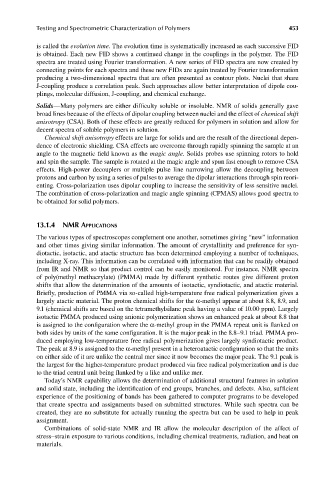Page 490 - Carrahers_Polymer_Chemistry,_Eighth_Edition
P. 490
Testing and Spectrometric Characterization of Polymers 453
is called the evolution time. The evolution time is systematically increased as each successive FID
is obtained. Each new FID shows a continued change in the couplings in the polymer. The FID
spectra are treated using Fourier transformation. A new series of FID spectra are now created by
connecting points for each spectra and these new FIDs are again treated by Fourier transformation
producing a two-dimensional spectra that are often presented as contour plots. Nuclei that share
J-coupling produce a correlation peak. Such approaches allow better interpretation of dipole cou-
plings, molecular diffusion, J-coupling, and chemical exchange.
Solids—Many polymers are either difficulty soluble or insoluble. NMR of solids generally gave
broad lines because of the effects of dipolar coupling between nuclei and the effect of chemical shift
anisotropy (CSA). Both of these effects are greatly reduced for polymers in solution and allow for
decent spectra of soluble polymers in solution.
Chemical shift anisotropy effects are large for solids and are the result of the directional depen-
dence of electronic shielding. CSA effects are overcome through rapidly spinning the sample at an
angle to the magnetic field known as the magic angle. Solids probes use spinning rotors to hold
and spin the sample. The sample is rotated at the magic angle and spun fast enough to remove CSA
effects. High-power decouplers or multiple pulse line narrowing allow the decoupling between
protons and carbon by using a series of pulses to average the dipolar interactions through spin reori-
enting. Cross-polarization uses dipolar coupling to increase the sensitivity of less sensitive nuclei.
The combination of cross-polarization and magic angle spinning (CPMAS) allows good spectra to
be obtained for solid polymers.
13.1.4 NMR APPLICATIONS
The various types of spectroscopes complement one another, sometimes giving “new” information
and other times giving similar information. The amount of crystallinity and preference for syn-
diotactic, isotactic, and atactic structure has been determined employing a number of techniques,
including X-ray. This information can be correlated with information that can be readily obtained
from IR and NMR so that product control can be easily monitored. For instance, NMR spectra
of poly(methyl methacrylate) (PMMA) made by different synthetic routes give different proton
shifts that allow the determination of the amounts of isotactic, syndiotactic, and atactic material.
Briefly, production of PMMA via so-called high-temperature free radical polymerization gives a
largely atactic material. The proton chemical shifts for the α-methyl appear at about 8.8, 8.9, and
9.1 (chemical shifts are based on the tetramethylsilane peak having a value of 10.00 ppm). Largely
isotactic PMMA produced using anionic polymerization shows an enhanced peak at about 8.8 that
is assigned to the configuration where the α-methyl group in the PMMA repeat unit is fl anked on
both sides by units of the same configuration. It is the major peak in the 8.8–9.1 triad. PMMA pro-
duced employing low-temperature free radical polymerization gives largely syndiotactic product.
The peak at 8.9 is assigned to the α-methyl present in a heteroatactic configuration so that the units
on either side of it are unlike the central mer since it now becomes the major peak. The 9.1 peak is
the largest for the higher-temperature product produced via free radical polymerization and is due
to the triad central unit being flanked by a like and unlike mer.
Today’s NMR capability allows the determination of additional structural features in solution
and solid state, including the identification of end groups, branches, and defects. Also, suffi cient
experience of the positioning of bands has been gathered to computer programs to be developed
that create spectra and assignments based on submitted structures. While such spectra can be
created, they are no substitute for actually running the spectra but can be used to help in peak
assignment.
Combinations of solid-state NMR and IR allow the molecular description of the affect of
stress–strain exposure to various conditions, including chemical treatments, radiation, and heat on
materials.
9/14/2010 3:42:13 PM
K10478.indb 453
K10478.indb 453 9/14/2010 3:42:13 PM

